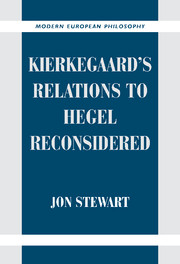Book contents
- Frontmatter
- Contents
- Acknowledgements
- Abbreviations of Primary Texts
- Preface
- Introduction
- 1 Kierkegaard and Danish Hegelianism
- 2 Traces of Hegel in From the Papers of One Still Living and the Early Works
- 3 The Ironic Thesis and Hegel's Presence in The Concept of Irony
- 4 Hegel's Aufhebung and Kierkegaard's Either/Or
- 5 Kierkegaard's Polemic with Martensen in Johannes Climacus, or De omnibus dubitandum est
- 6 Kierkegaard's Repetition and Hegel's Dialectical Mediation
- 7 Hegel's View of Moral Conscience and Kierkegaard's Interpretation of Abraham
- 8 Martensen's Doctrine of Immanence and Kierkegaard's Transcendence in the Philosophical Fragments
- 9 The Dispute with Adler in The Concept of Anxiety
- 10 The Polemic with Heiberg in Prefaces
- 11 Subjective and Objective Thinking: Hegel in the Concluding Unscientific Postscript
- 12 Adler's Confusions and the Results of Hegel's Philosophy
- 13 Kierkegaard's Phenomenology of Despair in The Sickness unto Death
- 14 Kierkegaard and the Development of Nineteenth-Century Continental Philosophy: Conclusions, Reflections, and Reevaluations
- Foreign Language Summaries
- Bibliographies
- Subject Index
- Index of Persons
13 - Kierkegaard's Phenomenology of Despair in The Sickness unto Death
Published online by Cambridge University Press: 13 March 2010
- Frontmatter
- Contents
- Acknowledgements
- Abbreviations of Primary Texts
- Preface
- Introduction
- 1 Kierkegaard and Danish Hegelianism
- 2 Traces of Hegel in From the Papers of One Still Living and the Early Works
- 3 The Ironic Thesis and Hegel's Presence in The Concept of Irony
- 4 Hegel's Aufhebung and Kierkegaard's Either/Or
- 5 Kierkegaard's Polemic with Martensen in Johannes Climacus, or De omnibus dubitandum est
- 6 Kierkegaard's Repetition and Hegel's Dialectical Mediation
- 7 Hegel's View of Moral Conscience and Kierkegaard's Interpretation of Abraham
- 8 Martensen's Doctrine of Immanence and Kierkegaard's Transcendence in the Philosophical Fragments
- 9 The Dispute with Adler in The Concept of Anxiety
- 10 The Polemic with Heiberg in Prefaces
- 11 Subjective and Objective Thinking: Hegel in the Concluding Unscientific Postscript
- 12 Adler's Confusions and the Results of Hegel's Philosophy
- 13 Kierkegaard's Phenomenology of Despair in The Sickness unto Death
- 14 Kierkegaard and the Development of Nineteenth-Century Continental Philosophy: Conclusions, Reflections, and Reevaluations
- Foreign Language Summaries
- Bibliographies
- Subject Index
- Index of Persons
Summary
Kierkgaard's short, yet influential, work The Sickness Unto Death appeared on July 30, 1849. The book was written a full year earlier in the spring of 1848. Kierkegaard kept the manuscript for several months along with a number of other works that he had recently completed before he decided to have it printed. One of the reasons for the delay was that he was contemplating publishing it as a part of a larger work that included parts of Practice in Christianity, The Point of View, Armed Neutrality, and Two Ethical-Religious Essays. This is clear from his journals, where he writes: “My intention was to publish all the completed manuscripts in one volume, all under my name – and then to make a clean break.” In the end, of course, the works were published individually, some signed and some pseudonymous.
With regard to its content, The Sickness unto Death can be seen as a kind of Christian psychology or anthropology. Part One is divided into three sections labeled simply A, B, and C. In the first section Kierkegaard's pseudonym Anti-Climacus analyzes the notion of despair, which, he argues, is the sickness unto death. In Section B, he makes the case that this sickness is more widespread than is generally recognized. In Section C, “The Forms of the Sickness,” he gives a taxonomy of the various forms of despair in accordance first with the categories of finitude/infinitude and possibility/necessity and then later with the levels of consciousness.
- Type
- Chapter
- Information
- Kierkegaard's Relations to Hegel Reconsidered , pp. 550 - 595Publisher: Cambridge University PressPrint publication year: 2003

